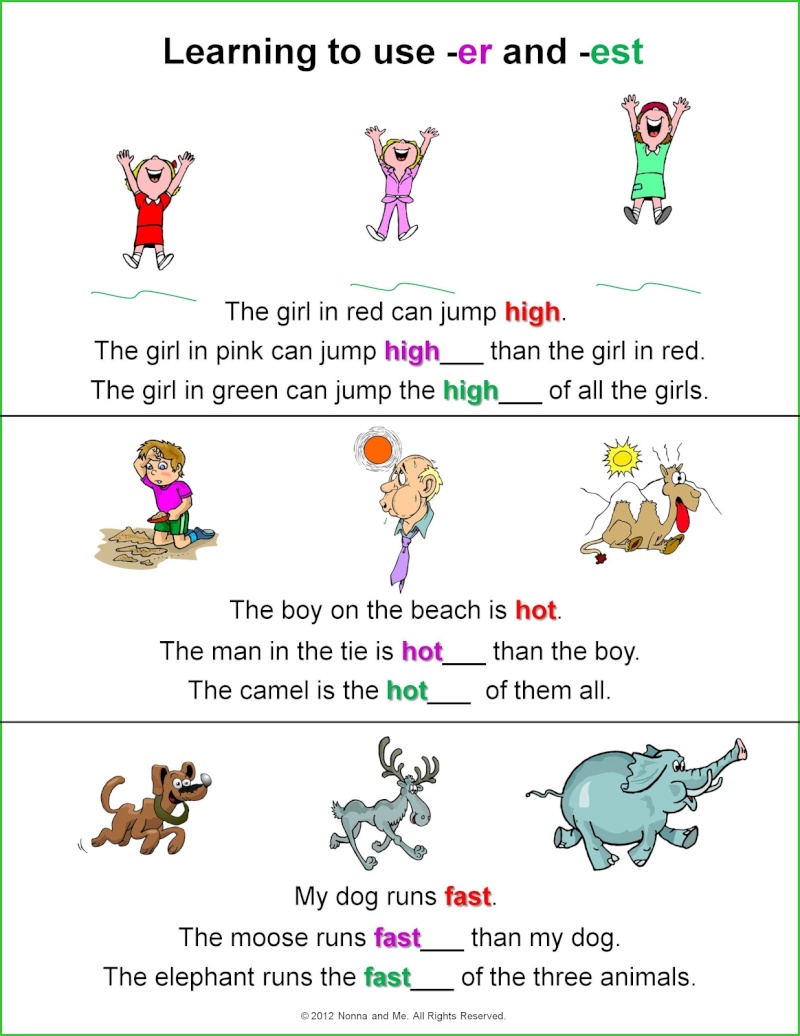Adjective and Adverb Usage
Page 1 of 1
 Adjective and Adverb Usage
Adjective and Adverb Usage
Effective use of adjectives and adverbs can make the difference between a dull sentence and an interesting one. Skilled writers use these two parts of speech much as an artist uses color - for contrast, for emphasis and for shades of meaning.
One important use of modifiers is to make comparisons. This section will show you how to form different adjectives and adverbs in order to make comparisons.
DEGREES OF COMPARISON:
In English, there are three degrees, or forms, of adjectives and adverbs that are used in comparisons.
Most adjectives and adverbs have different forms to show degrees of comparison.
RECOGNIZING DEGREES OF COMPARISON:
In order to recognize the three degrees of comparison, you need to know the name of each degree.
The three degrees of comparison are the positive, the comparative, and the superlative.
There are three ways that a word may change form to indicate the comparative and superlative degrees: (1) with '-er' and '-est'. (2) with more and most, and (3) with entirely different words.
+ DEGREES OF ADJECTIVE
Positive: quick, pleasant, bad
Comparative: quicker, more pleasant, worse
Superlative: quickest, most pleasant, worst
+ DEGREES OF ADVERBS
Positive: slow, pleasantly, badly
Comparative: slower, more pleasantly, worse
Superlative: slowest, most pleasantly, worst
REGULAR FORMS:
Adjectives and adverbs can be either regular or irregular, depending on how their comparative and superlative degrees are formed. The comparative and superlative degrees of most adjectives and adverbs are formed regularly. Two rules govern the formation of regular modifiers. The first concerns modifiers of one or two syllables; the second concerns modifiers of three or more syllables.
Add '-er' and '-est' to form the comparative and superlative degrees of most modifiers with one or two syllables.
The examples below show one- and two-syllable modifiers developed in the customary manner with '-er' and '-est'.
Examples:
bright >> brighter >> brightest
crafty >> craftier >> craftiest
subtle >> subtler >> subtlest
Use more and most to form the comparative and superlative degrees of all modifiers with three or more syllables.
Examples:
delicate >> more delicate >> most delicate
dependable >> more dependable >> most dependable
ambitious >> more ambitious >> most ambitious
More and most are used with a number of one- and two-syllable modifiers when '-er' and '-est' would sound awkward. Rely on your ear to determine which word sounds awkward with '-er' and '-est'.
Examples:
just >> more just >> most just
pleasing >> more pleasing >> most pleasing
vicious >> more vicious >> most vicious
All adverbs that end in '-ly', regardless of the number of syllables, form their comparative and superlative degrees with more and most.
freely >> more freely >> most freely
happily >> more happily >> most happily
http://tx.english-ch.com/teacher/mar/home/adjective-and-adverb-usage/

Vincent Law- Advanced Fluency

- Posts : 1537
Join date : 2011-12-22
Age : 49
Location : Philadelphia
 Re: Adjective and Adverb Usage
Re: Adjective and Adverb Usage
More About '-er' and '-est' (adjectives) :
Let's continue where we left off before we took a short break. We were learning about adjectives...more specifically, the three degrees of adjectives.
- Positive degree: used to express a quality without comparing
- Comparative degree (-er): used to express a higher or lower degree of change (between two things)
- Superlative degree (-est): used to express the highest or lowest level of change (between three or more things)
Using the pictures as a guide, read the three sentences in each box. Ask your child to choose the correct endings ('-er' or '-est') that are missing in the second and third sentences. Reinforce the concept that '-er' is when you are comparing two things and '-est' is used when you are comparing three or more things. Write the correct endings on the provided lines.
Note: Point out that sometimes you have to double the last letter of the word before adding the '-er' and '-est' (like the word hot on the activity sheet.) Here are some common words that also fit into this category: big, wet, mad, and sad.
http://nonnaandme.blogspot.fr/2012/06/back-to-business-more-about-er-and-est.html
Let's continue where we left off before we took a short break. We were learning about adjectives...more specifically, the three degrees of adjectives.
- Positive degree: used to express a quality without comparing
- Comparative degree (-er): used to express a higher or lower degree of change (between two things)
- Superlative degree (-est): used to express the highest or lowest level of change (between three or more things)
Using the pictures as a guide, read the three sentences in each box. Ask your child to choose the correct endings ('-er' or '-est') that are missing in the second and third sentences. Reinforce the concept that '-er' is when you are comparing two things and '-est' is used when you are comparing three or more things. Write the correct endings on the provided lines.
Note: Point out that sometimes you have to double the last letter of the word before adding the '-er' and '-est' (like the word hot on the activity sheet.) Here are some common words that also fit into this category: big, wet, mad, and sad.
http://nonnaandme.blogspot.fr/2012/06/back-to-business-more-about-er-and-est.html

Vincent Law- Advanced Fluency

- Posts : 1537
Join date : 2011-12-22
Age : 49
Location : Philadelphia
 Similar topics
Similar topics» The Adverb
» Average Smartphone Usage
» Common English Usage Misconceptions
» GRAMMAR - Comma Usage: Restrictive vs. Nonrestrictive Relative Clauses
» Average Smartphone Usage
» Common English Usage Misconceptions
» GRAMMAR - Comma Usage: Restrictive vs. Nonrestrictive Relative Clauses
Page 1 of 1
Permissions in this forum:
You cannot reply to topics in this forum|
|
|



